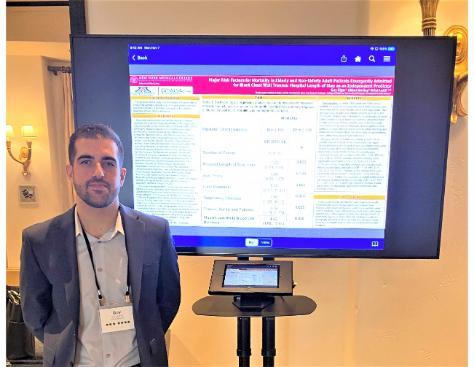Comorbidities and Hospital Length of Stay Key Mortality Predictors After Blunt Thoracic Trauma
Blunt Thoracic Trauma Contributes Significantly to Morbidity and Health Care-Related Financial Strain

Blunt thoracic trauma is responsible for 35 percent of trauma-related deaths in the United States and significantly contributes to morbidity and health care-related financial strain. A newly published study conducted by Guy Elgar, SOM Class of 2025, and Abbas Smiley, M.D., research assistant professor of surgery, found that comorbidities were a greater factor influencing mortality in emergently admitted patients with blunt chest wall trauma than advanced age, as had been reported in previous studies.
“Our findings indicate that the relationship between mortality, blunt chest wall trauma and advanced age may be more nuanced than previously suspected,” said Elgar, who recently presented his research at the Western Surgical Association Annual Meeting. “Without controlling for patient characteristics, age can serve as a surrogate factor that potentially contains the true mortality-associated variables, such as injury severity, the mechanism of blunt chest wall trauma and seriousness of the patient’s comorbidities.”
For the study, Elgar and Dr. Smiley examined data from the National Inpatient Sample repository for patients who were emergently admitted with a primary diagnosis of blunt chest wall trauma compiled over a ten-year period. Elderly and nonelderly adult patients both displayed relatively low mortality rates of one percent, demonstrating no statistically significant association between mortality and age, which is incongruent with previous studies that found advanced age to be associated with higher rates of mortality for patients with blunt thoracic trauma. Yet, for every additional day patients stayed in the hospital, the odds of mortality increased by nine percent.
“We suspect that the increased mortality rates observed in patients with increased hospital lengths of stay may be attributed to nosocomial infections and correspondingly patients with higher acuity who require longer stays,” said Elgar.
Elgar, who got involved in the research to improve the outcomes for trauma patients, credits Dr. Smiley for being a tremendous mentor. “Dr. Smiley provided expert guidance on all aspects of the paper and has been highly supportive in the publishing process. I am very grateful to have had the opportunity to play a significant role in research and present the study at a conference, which was a great way to network and learn with other physicians and medical students,” said Elgar, who is currently involved in research on pre-hospital trauma.
